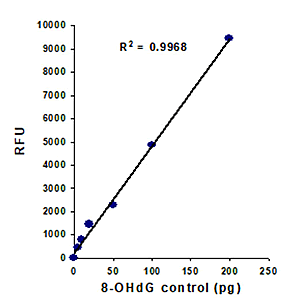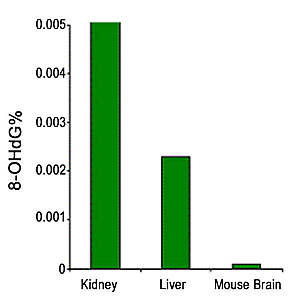EpiQuik 8-OHdG DNA Damage Quantification Direct Kit (Fluorometric)
| Specifications | |
|---|---|
| Research Area: | Oxidative Stress |
| Assay Category: | DNA/RNA Damage and Repair Assays |
| Sample Type: | Cultured cells, fresh and frozen tissues, paraffin-embedded tissues, body fluid samples etc. |
| Species Reactivity: | Any species such as mammals, plants, fungi, bacteria, and viruses |
| Detection Method: | Fluorometric |
Product Description
- Easy-to-follow steps for convenience and speed
- High sensitivity (see Fig.1) and High specificity
- Direct detection of 8-OHdG using intact DNA
- Detection accuracy is highly correlated with and close to HPLC or LC-MS analysis
- Direct use of DNA isolated from cells or tissues
- Universal positive and negative controls included
- Suitable for manual or high throughput analysis
The EpiQuik™ 8-OHdG DNA Damage Quantification Direct Kit (Colorimetric) is a complete set of optimized buffers and reagents to fluorometrically detect and quantify oxidative DNA damage (8-OHdG) directly using DNA isolated from any species such as mammals, plants, fungi, bacteria, and viruses in a variety of forms including, but not limited to, cultured cells, fresh and frozen tissues, paraffin-embedded tissues, and body fluid samples.
Principle & Procedure
The EpiQuik™ 8-OHdG DNA Damage Quantification Direct Kit (Fluorometric) contains all reagents necessary for the quantification of Oxidative DNA damage (8-OHdG). In this assay, DNA is bound to strip wells that are specifically treated to have a high DNA affinity. 8-OHdG is detected using capture and detection antibodies. The detected signal is enhanced and then quantified fluorometrically by reading the fluorescence in a fluorescence microplate reader. The amount of 8-OHdG is proportional to the fluorescence intensity measured.
Starting Materials & Input Amount
DNA amount can range from 100 ng to 300 ng per reaction. An optimal amount is 300 ng per reaction. Starting DNA may be in water or in a buffer such as TE.
Safe and Convenient
All the necessary reagents, including negative controls and positive controls, for the quantification of 8-OHdG are conveniently packaged in the kit. The direct fluorometric quantification of DNA samples replaces obsolete or inferior methods and eliminates the need for DNA digestion/denaturation, radioactivity, extraction, or chromatography.
Responsive, Reliable, and Practical
Based on its working principle and the microplate format, the kit can be practically and routinely used for any species in a variety of forms including cultured cells, fresh and frozen tissues, and paraffin-embedded tissues. To demonstrate the capabilities of the kit, it has been successfully used for quantifying the content of 8-OHdG in DNA from human kidney, liver, and mouse brain tissues. The percentage of 8-OHdG measured by the kit is similar and comparable to that detected by HPLC methods (see Table 1 and Fig.2).

Table 1. Comparison of Specifications with competitors

Fig.1. 8-OHdG standard control was added into the assay wells at different concentrations and then measured with the EpiQuik 8-OHdG DNA Damage Quantification Direct Kit.

Fig.2. Percentage of 8-OHdG in different tissues measured with the EpiQuik 8-OHdG DNA Damage Quantification Direct Kit (Fluorometric).
Product Citations
- Wysong BC, Logan Schuck P, Sridharan M, Carrison S, Murakami Y, Balakrishnan L, Stewart JA (2024) HUMAN CST STIMULATES BASE EXCISION REPAIR TO PREVENT THE ACCUMULATION OF OXIDATIVE DNA DAMAGE. J Mol Biol
- Domínguez-Zorita S, Romero-Carramiñana I, Santacatterina F, Esparza-Moltó PB, Simó C, Del-Arco A, Núñez de Arenas C, Saiz J, Barbas C, Cuezva JM (2023) IF1 ablation prevents ATP synthase oligomerization, enhances mitochondrial ATP turnover and promotes an adenosine-mediated pro-inflammatory phenotype. Cell Death Dis
- Onorato G, Fardella F, Lewinska A, Gobbo F, Tommasini G, Wnuk M, Tino A, Moros M, Antognazza MR, Tortiglione C (2022) Optical Control of Tissue Regeneration through Photostimulation of Organic Semiconducting Nanoparticles. Adv Healthc Mater
- Chen ZY et al. (2016) Cadmium Exposure Enhances Bisphenol A-Induced Genotoxicity through 8-Oxoguanine-DNA Glycosylase-1 OGG1 Inhibition in NIH3T3 Fibroblast Cells. Cell Physiol Biochem 39(3):961-974
- Ande A et al. (2015) Effect of Mild-to-Moderate Smoking on Viral Load, Cytokines, Oxidative Stress, and Cytochrome P450 Enzymes in HIV-Infected Individuals. PLoS One 10(4):e0122402
- Catalog Number
P-6004-48-EP - Supplier
EpigenTek - Size
- Shipping
Blue Ice

